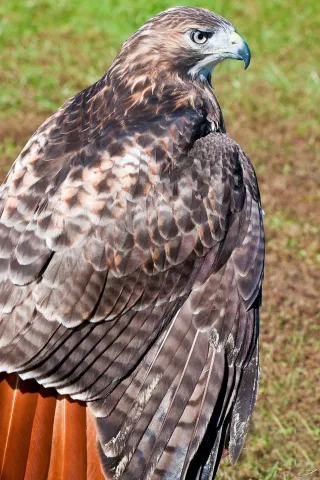The red-tail: King of the hawks

Photo by Harold Jerrell
By: Steve Roark
Volunteer Interpreter, Cumberland Gap National Historical Park
While several hawk species spend time in East Tennessee, the red-tailed hawk stays around all year and is the most common one seen.
They prefer to hang out in open fields near woodland edges. Seeing a red tail gliding across the sky and hearing their high-pitched cry gives one a pleasing dose of wildness.
The red-tailed hawk (Buteo jamaicensis) has a body around two feet long with wide wings that span around 4 four feet, making it the largest hawk we have. The female is a third larger than the male. The tail is broad, rounded, and indeed red on top. It may not be obvious when looking up at the underside of the bird, but sunlight filtering through the tail feathers may make the tail appear red from below. You may also catch a flash of color when the hawk banks in flight. Another identifying feature to look for is a band of brown streaks across an otherwise white belly. The cry of this hawk is a high-pitched “keer-r-r-r-r” that fades downward.
The red tail is a bird of prey, doing a beneficial job of keeping rodent populations in check, which make up around 90 percent of their diet. Their tactic is to swoop down onto prey from a high observation point, extending their talons forward for the kill. They are capable of “kiting,” holding still against the wind on set wings, much like a kite tugging against string. This allows them to hover over potential prey before dropping the hammer.
Few birds can do this. Like all raptors, they have excellent vision, and can see colors like we can, as well as those in the ultraviolet, which we cannot. They also perceive black and white well enough to be able to hunt rodents at dusk when they are most active.
Red-tails typically do not begin breeding until their third year. Pairs build a large stick nest near the top of a tree (usually deciduous) at forest edges. Two to four eggs are usually laid in April or May, hatching in about 30 days. The young remain in the vicinity of the nest until they can fly, then follow their parents as they learn to forage for themselves. There is only one brood per year.
Hawks were once killed on site due to their threat to chickens back when subsistence farming was the norm. Due to protection laws and social changes, they again have a stable population.
- Log in to post comments